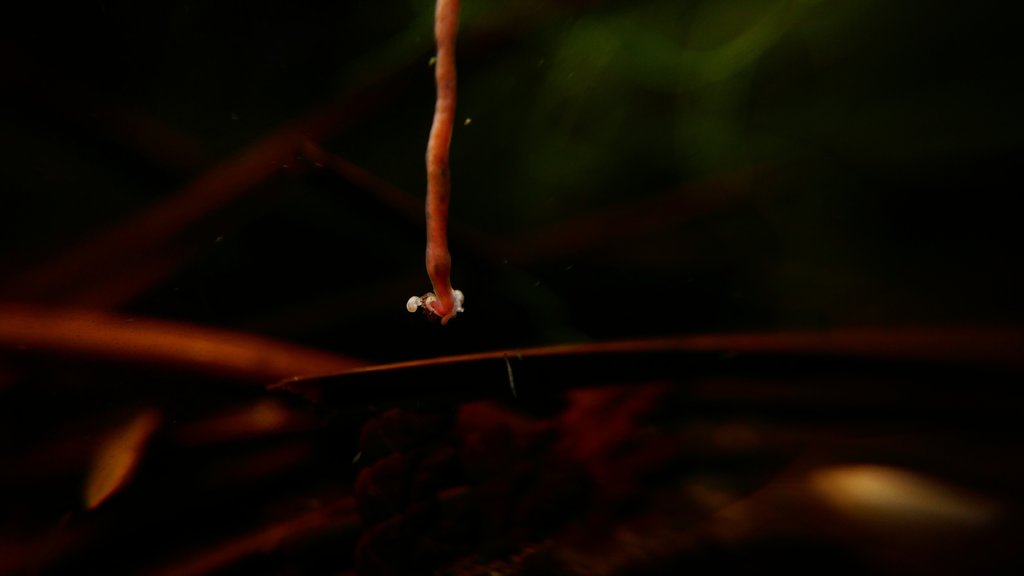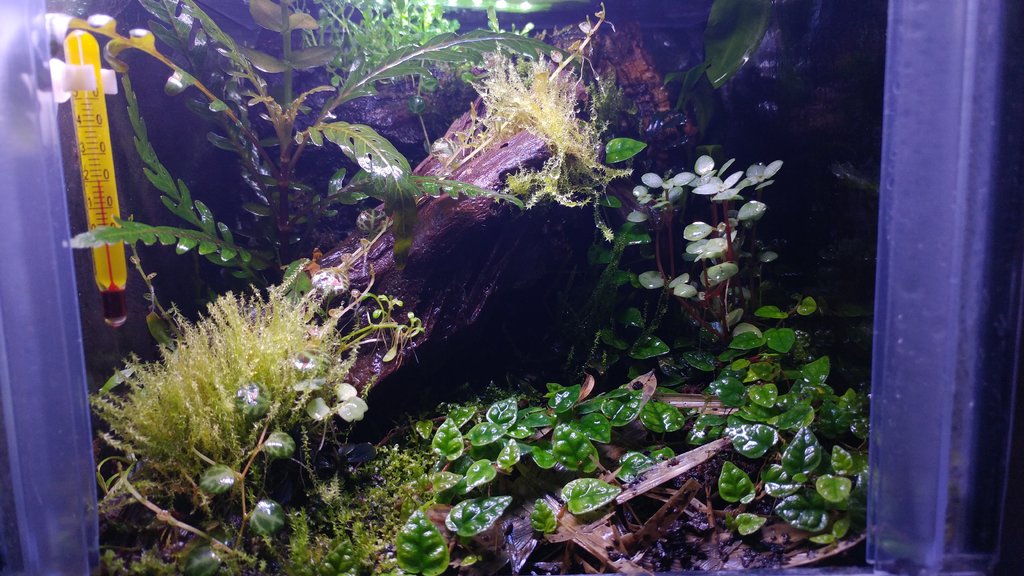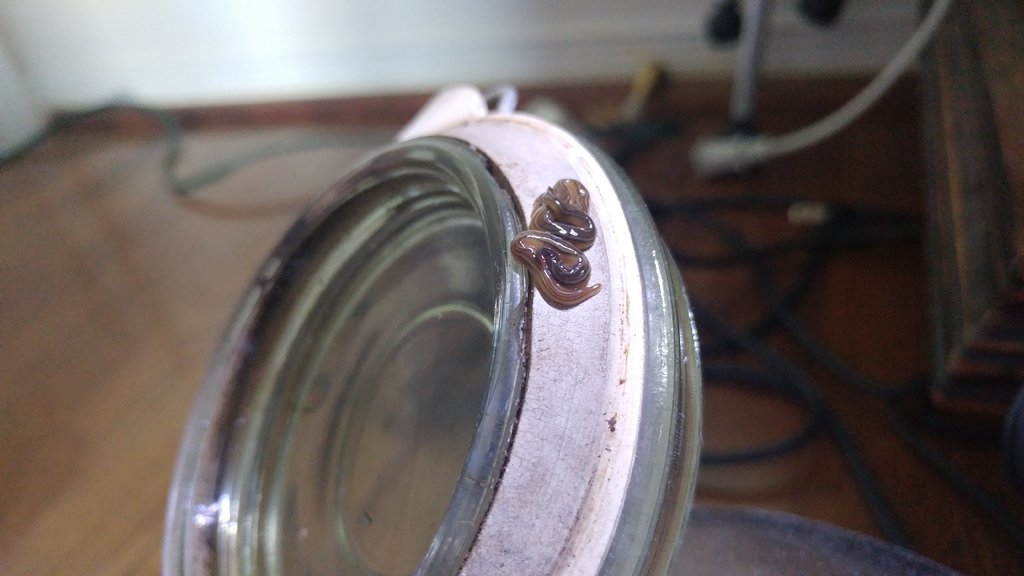Umbra
Arachnopeon
- Joined
- Dec 1, 2013
- Messages
- 48
In light of the fantastic slug and leech threads, I figured I'd dedicate a post to some of my slimy, spineless wonders, the nemerteans (ribbon worms) and flatworms. I feel these are even more obscure in the pet trade than the others - the only flatworms most people know of are the species that are seen in science labs/freshwater shrimp aquariums. Ribbon worms most people have probably never seen outside of a few viral videos featuring marine species. I'd bet out of those who are familiar with them the majority aren't aware of the terrestrial species.
I'll start with my freshwater ribbon worm, Prostoma cf. canadiensis. These were collected in a local river through the use of a bottom sampling dredge. They are pretty neat little predators of other worms, insect larvae and small crustaceans. The max size seems to be around 35mm. Their distribution is sporadic at best, being very common in some stretches and absent in others. Clear runs with mixture of cobble and sand sediment with an abundance of rooted plants seem to produce the best. They have been breeding for me on and off and seem to have a decently long lifespan.


Next up is my terrestrial nemertean, Geonemertes pelaensis. These guys are much larger than the aforementioned species, with some of my specimens passing the 120mm mark. They are voracious predators of arthropods - mine have been eating primarily crickets although they'll take whatever else I'll throw in there for variety. The white isopods I put in there as clean up crew look to have been eaten as well. They are exceedingly shy and light sensitive, and only come out and forage in the dimmest of light or pitch blackness. As a result of this behavior I've only ever seen prey capture once.
G. pelaensis are cyclic hermaphrodites, transitioning back and forth between male and female and some literature suggests that they may be capable of self fertilization during some points of their transitions. I've found a few egg sacs but I haven't seen any produce viable young yet. I keep a constant supply of springtails going in there just in case.



I also have some unidescribed Caenoplana sp. These are not nemerteans but are terrestrial planarians. They appear to be generalist predators but seem to have a strong penchant for spiders in particular. This species reproduces by fragmentation - I've never seen them breed, never seen an egg case but I've seen them multiply by splitting. This has been confirmed by a professor in Australia who is an authority on terrestrial planaria. They don't appear to be as arboreal as G. pelaensis nor are they anywhere near as active even after lights out - they are more than content to simply sit in the same spot for days on end until it's time to feed. The largest one I have is about 85-90mm fully extended.

I also have a small species of terrestrial planarian, Rhynchodemus sylvaticus. These are tiny, maybe 30mm max but are efficient predators nonetheless. Mine have taken down prey as large as yellow sac spiders and small Trochosa sp. wolf spiders but I feed them primarily on Drosophila and springtails. They reproduce quite quickly and can populate a small vivarium very quickly. Most notable of this genus are the pair of conspicuous eyes on the head, they are IMO one of the neatest looking little worms. I don't have any good photos right now but I will try and get some good ones in the upcoming days. For now here is a photo of the vivarium I'm keeping them in!

I have a few more species that I will post about at a later date - if anyone has any experience keeping any ribbon worms/flatworms I'd love to hear about your experiences!
I'll start with my freshwater ribbon worm, Prostoma cf. canadiensis. These were collected in a local river through the use of a bottom sampling dredge. They are pretty neat little predators of other worms, insect larvae and small crustaceans. The max size seems to be around 35mm. Their distribution is sporadic at best, being very common in some stretches and absent in others. Clear runs with mixture of cobble and sand sediment with an abundance of rooted plants seem to produce the best. They have been breeding for me on and off and seem to have a decently long lifespan.
Next up is my terrestrial nemertean, Geonemertes pelaensis. These guys are much larger than the aforementioned species, with some of my specimens passing the 120mm mark. They are voracious predators of arthropods - mine have been eating primarily crickets although they'll take whatever else I'll throw in there for variety. The white isopods I put in there as clean up crew look to have been eaten as well. They are exceedingly shy and light sensitive, and only come out and forage in the dimmest of light or pitch blackness. As a result of this behavior I've only ever seen prey capture once.
G. pelaensis are cyclic hermaphrodites, transitioning back and forth between male and female and some literature suggests that they may be capable of self fertilization during some points of their transitions. I've found a few egg sacs but I haven't seen any produce viable young yet. I keep a constant supply of springtails going in there just in case.
I also have some unidescribed Caenoplana sp. These are not nemerteans but are terrestrial planarians. They appear to be generalist predators but seem to have a strong penchant for spiders in particular. This species reproduces by fragmentation - I've never seen them breed, never seen an egg case but I've seen them multiply by splitting. This has been confirmed by a professor in Australia who is an authority on terrestrial planaria. They don't appear to be as arboreal as G. pelaensis nor are they anywhere near as active even after lights out - they are more than content to simply sit in the same spot for days on end until it's time to feed. The largest one I have is about 85-90mm fully extended.
I also have a small species of terrestrial planarian, Rhynchodemus sylvaticus. These are tiny, maybe 30mm max but are efficient predators nonetheless. Mine have taken down prey as large as yellow sac spiders and small Trochosa sp. wolf spiders but I feed them primarily on Drosophila and springtails. They reproduce quite quickly and can populate a small vivarium very quickly. Most notable of this genus are the pair of conspicuous eyes on the head, they are IMO one of the neatest looking little worms. I don't have any good photos right now but I will try and get some good ones in the upcoming days. For now here is a photo of the vivarium I'm keeping them in!
I have a few more species that I will post about at a later date - if anyone has any experience keeping any ribbon worms/flatworms I'd love to hear about your experiences!
